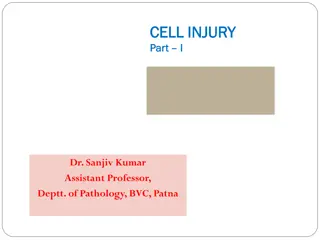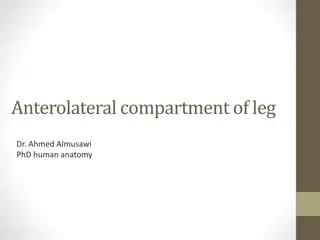SMALL FIBRE
Small fiber neuropathy involves thin and unmyelinated nerve fibers, leading to various sensory disturbances. The Erlanger and Gasser classification details the different types of nerve fibers involved. Symptoms include burning, tingling, and numbness, often presenting in a stocking-glove pattern. Di
4 views • 53 slides
Cross-Border Injury Claims in Canada_ Navigating Legal Complexities for Fair Compensation(20_03_2024)
Cross-Border Injury Claims in Canada: Navigating Legal Complexities for Fair Compensation\n\nIn the vast landscape of Canadian law, navigating the complexities of cross-border accidents and injuries requires a specialized approach. From out-of-province accidents to cross-border motor vehicle collisi
0 views • 2 slides
Comprehensive Guide on Injury, Poisoning, and External Causes
This detailed guide covers various aspects of injuries, poisonings, and other consequences from external causes. It includes information on ICD10 and ICD9 coding, recording and treatment details, vocabulary related to different types of injuries, body parts classification, and code structures for di
2 views • 39 slides
Nerve and muscle physiology
The lecture delves into the intricate structure of nerves, highlighting the morphology of nerve fibers and the process of myelination. It explores the classification of nerve fibers, emphasizing the role of dendrites, axons, and synaptic functions in the nervous system. The significance of Schwann c
4 views • 29 slides
Injury Surveillance in Scotland: Importance and Implementation Overview
Scotland's Public Health body, Public Health Scotland, leads efforts in injury surveillance to prolong healthy life, prevent disease, and promote health. Long-term investment in prevention involves various sectors. Injury surveillance is crucial as it helps manage and prevent injuries, with coded da
4 views • 24 slides
Physiotherapy Rehabilitation for Post Ligament Injury - Varsha Jalandhara, DPT
In the acute stage of post-ligament injury, physiotherapy focuses on reducing inflammation and pain through techniques like cryotherapy and protective measures. As the injury progresses to the sub-acute stage, mobilization and strengthening exercises are gradually introduced to improve range of moti
2 views • 26 slides
Brain Injury Services: Empowering Recovery and Support
At Brain Injury Services, we are committed to making a positive difference in the lives of individuals affected by brain injury. Through our comprehensive support services, compassionate care, and commitment to empowerment, we empower survivors to overcome obstacles, reclaim their independence, and
6 views • 7 slides
Expert Construction Accident Attorney: Your Trusted Injury Lawyer
Our expert construction accident attorneys are dedicated to securing the compensation you deserve. With years of experience in handling complex injury cases, we navigate the legal intricacies to ensure your rights are protected. Trust us to provide compassionate and effective representation, helping
1 views • 13 slides
Injured Get the Best Lawyer for Personal Injury
After being hurt, don't suffer in quiet. Our personal injury lawyers at Bavariyalaw.com are here to assist you, and they will fight to get you the justice you are due.\n\n\n\/\/ \/personal-injury\/\n
1 views • 1 slides
Uncovering the Neglected Field of Injury Epidemiology
Exploring the realm of injury epidemiology, this content delves into the definitions, objectives, and hypotheses surrounding the study of injuries. It highlights the overlap between injury epidemiology and prevention while shedding light on why this field remains neglected, particularly in Canada. T
0 views • 70 slides
Understanding Intimate Partner Violence and Brain Injury Connections
The link between intimate partner violence (IPV) and brain injury is significant, with studies showing a high prevalence of brain injuries among IPV survivors, particularly women. Common types of IPV causing brain injury include hits to the head, strangulation, and banging the head against objects.
1 views • 23 slides
Understanding Nerves and Muscles: Physiology Insights by Dr. Amar AL-Musawi MD, PhD
Explore the intricate world of nerve fiber morphology, myelination, and classification in this enlightening lecture by Dr. Amar AL-Musawi. Delve into the significance of myelination in enhancing nerve function and learn about factors affecting conduction velocity. Discover the role of glial cells in
0 views • 15 slides
Guidelines for PECARN Head CT Decision Rule in Children with Minor Head Injury
Michigan Emergency Department Improvement Collaborative (MEDIC) endorses the PECARN Head CT Decision Rule for children with minor head injury to standardize and reduce overuse of CT scans. This rule, developed and vetted by experts, aims to improve clinical decision-making, reduce costs, radiation e
3 views • 11 slides
Understanding the Brachial Plexus Anatomy and Function
The brachial plexus is a crucial network of nerves in the upper limb, formed by nerve fibers originating from C5 to T1 spinal levels. It plays a significant role in innervating the upper extremity muscles and providing sensory feedback. The plexus is categorized into roots, trunks, divisions, cords,
0 views • 55 slides
Mechanism of General Anaesthesia Theories: Lipid Solubility, Surface Tension, Microcrystal, Protein Binding
Mechanism of general anaesthesia involves theories focusing on the interaction of anaesthetics with cell membrane components like lipids and proteins. The Lipid Solubility theory emphasizes the importance of an anaesthetic's affinity and solubility in nerve cell membranes, while the Surface Tension
1 views • 10 slides
Understanding OSHA Workplace Injuries Data Analysis
Analyze OSHA workplace injuries data from 2015 to 2017, including total recordable incident rates, number of injuries, total hours worked, city injury rates, and top locations with high injury rates. Explore the importance of using incident rates over total injury numbers and how departments benefit
0 views • 15 slides
Understanding Biomechanics of Sport Injury for Improved Protection
Identification of the causes and mechanisms of sports injuries through biomechanics is crucial for enhancing prevention strategies. This field explores how the human body responds to mechanical forces, risking injury if tissues fail to absorb stress. Impact injuries can lead to structural damage and
0 views • 29 slides
Understanding Subject Injury Policy and Reporting at OHSU
Explore the subject injury policy, identification process, and reporting guidelines at Oregon Health & Science University (OHSU). Learn how subject injuries are defined, identified, and distinguished from other reactions in research studies. Get insights into determining if an adverse experience qua
0 views • 17 slides
Leprosy Nerve Examination by Dr. N. K. Kansal
This informative content provides a detailed guide on leprosy nerve examination conducted by Dr. N. K. Kansal, an Associate Professor. It covers the procedure for palpation of a nerve, emphasizing correct patient positioning and gentle palpation techniques. The importance of comparing nerves on both
0 views • 16 slides
Understanding Cell Injury and Adaptation in Pathology
Rudolph Virchow's concept of disease starting at the cellular level highlights how cells constantly face challenges in maintaining homeostasis. The plasma membrane acts as a barrier against external stressors, but when cells face excessive physiological stresses or pathological stimuli, they adapt o
0 views • 16 slides
Understanding Facial Nerve Lesions: Clinical Scenarios and Anatomy Overview
A comprehensive exploration of facial nerve lesions through real-life clinical scenarios and detailed anatomical insights. Dive into cases involving trauma, fractures, and abscesses to understand the varied manifestations of these lesions. Learn about the functions of the facial nerve, its segments,
0 views • 22 slides
Personal Injury and Compensation Claims Overview
Stewarts law firm focuses on serious injury claims, emphasizing a client-centered approach to personal injury litigation. This presentation aims to provide a basic understanding of compensation claims for serious injuries, the difference between clinical negligence and personal injury cases, and the
0 views • 20 slides
Clinical Evaluation of Trigeminal Nerve Function
Sensory evaluation of trigeminal nerve function involves assessing exteroceptive sensations across its divisions, identifying sensory losses due to lesions, and distinguishing different types of lesions affecting sensation on the face. Motor evaluation focuses on the muscles of mastication to detect
0 views • 34 slides
Preventing Road Traffic Injuries: A Global Perspective
Road traffic injuries are a significant global issue, causing millions of deaths and injuries annually. This report highlights the complexity and dangers of road traffic systems, emphasizing the need for increased awareness and preventive measures at governmental, industrial, and individual levels.
1 views • 27 slides
Understanding Cellular Injury and Its Manifestations
Cellular injury can occur due to various factors like physical trauma, chemicals, radiation, and biologic agents. This process can lead to reversible or irreversible damage in cells, affecting their normal functions and possibly leading to cell death. Manifestations of cellular injury include cellul
0 views • 9 slides
The Intersection of Opioids and Brain Injury: Addressing Addiction Through a Brain Injury Informed Lens
Exploring the correlation between traumatic brain injury (TBI) and the opioid crisis, this content delves into the alarming statistics of opioid overdoses and their impact on individuals with brain injuries. Highlighting the overlap and consequences of these two major health issues, it sheds light o
0 views • 45 slides
Insights on Moral Injury Among Women Veterans: Preliminary Study Findings
Preliminary results from a grounded theory study on moral injury in U.S. women veterans reveal themes such as sexual assault, hostile work environments, and more. Participants shared their experiences, highlighting the nature of moral injury they faced, distinguishing between various forms of discri
0 views • 21 slides
Understanding Cell Injury and its Causes in Pathology
Rudolph Virchow's concept of disease starting at the cellular level is explored in this content, focusing on the impact of the external environment on cell equilibrium. The role of the plasma membrane as a barrier and the definitions of normal cell function, adaptation, reversible injury, irreversib
0 views • 16 slides
Safety Performance in Western Australia's Mineral Industry 2010-11
This presentation provides insights into safety performance in the Western Australian mineral industry for the year 2010-11. It includes definitions of key terms such as Lost Time Injury (LTI), Serious Injury, Minor Injury, Disabling Injury (DI), and various rates used to measure safety performance.
0 views • 21 slides
Exploring the Olfactory Nerve and Its Role in the Sense of Smell
The olfactory nerve, the first cranial nerve, plays a crucial role in our sense of smell. It is unique for its ability to regenerate, with basal cells facilitating this process. The olfactory system is responsible for detecting odors and is essential for various behaviors in mammals. This system con
0 views • 20 slides
International Collaborative Effort on Injury Statistics and Methods (Injury.ICE)
Injury.ICE is a global collaboration dedicated to standardizing methods for comparing injury statistics worldwide to inform policy responses. The organization welcomes participation from academia, government statistical agencies, and NGOs. The structure includes a Steering Committee and open members
0 views • 8 slides
Effective Strategies for Injury Prevention in Trauma Centers
Organized and data-driven injury prevention activities are crucial in trauma centers. Community partnerships, evidence-based reviews, designated injury prevention coordinators, and involvement of trauma personnel are key elements for successful injury prevention. Targeting contributing factors like
0 views • 20 slides
Understanding Facial Nerve Disorders: An Overview
Facial nerve disorders can lead to various symptoms such as facial paralysis and otalgia. This article covers the embryology, anatomy, and neuropathophysiology of the facial nerve. The development of the facial nerve complex occurs in the early stages of gestation, and abnormalities may be associate
0 views • 39 slides
Journey from Esotropia Resulting from Bilateral 6th Nerve Palsy in Infancy to Orthotropia
A detailed case study presented at the 9th Annual State Ophthalmological Conference showcases the successful management of esotropia resulting from bilateral 6th nerve palsy. The journey of a 30-year-old male patient from childhood inward eye deviation to achieving orthotropia post-surgical interven
0 views • 6 slides
Managing Risk in Brain Injury: Strategies and Considerations
This informative content covers essential aspects of risk management in brain injury, including balancing client needs, promoting independence, and positive risk taking. It delves into the different parts of the brain, their functions, and the potential effects of brain injury on intellectual, behav
0 views • 14 slides
Understanding Acquired Brain Injury: Facts, Challenges, and Stories
Acquired Brain Injury (ABI) is a complex condition that encompasses various causes such as traumatic brain injury, stroke, brain aneurysm, and more. This type of injury can lead to cognitive, physical, and communication difficulties, impacting individuals in profound ways. Survivors of ABI may face
2 views • 24 slides
Overview of Leg Compartments and Nerve Supply in Human Anatomy
This informative content provides detailed insights into the anterolateral compartment of the leg, facial compartments, muscles in the lateral compartment, nerve supply, anterior compartment of the leg, blood, and nerve supply, deep fibular nerve distribution, dorsum and dorsalis pedis artery. It di
0 views • 10 slides
Understanding Electrical Concepts in Nerve Conduction Studies
Exploring the fundamental electrical properties in nerve conduction studies, including charge, voltage, current, and impedance. Learn about normal values, anatomy, and anomalies in nerve function. This self-study curriculum is designed for technologists interested in electromyography and nerve condu
0 views • 73 slides
Overview of Peripheral Nerve Injuries and Brachial Plexus Injuries
Explore different types of peripheral nerve injuries including Erb's palsy, Klumpke palsy, isolated axillary nerve injury, and isolated musculocutaneous nerve injury. Learn about the anatomy, causes, motor and sensory exams, and management of these injuries. Understand the myotomes and dermatomes as
0 views • 19 slides
Comparative Analysis of Injury Statistics Between Colorado and National Data
This study compares injury statistics between Colorado and national data, focusing on injury deaths, hospitalizations, and diagnosis codes. The purpose is to analyze NHDS and HCUPNet data for national estimates, highlighting differences in hospital discharges for various injury categories. The analy
0 views • 13 slides







































